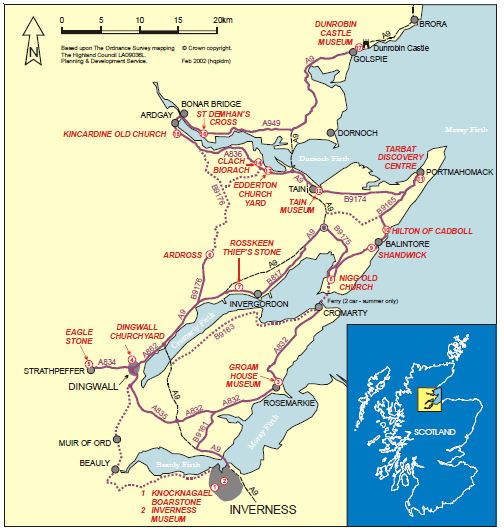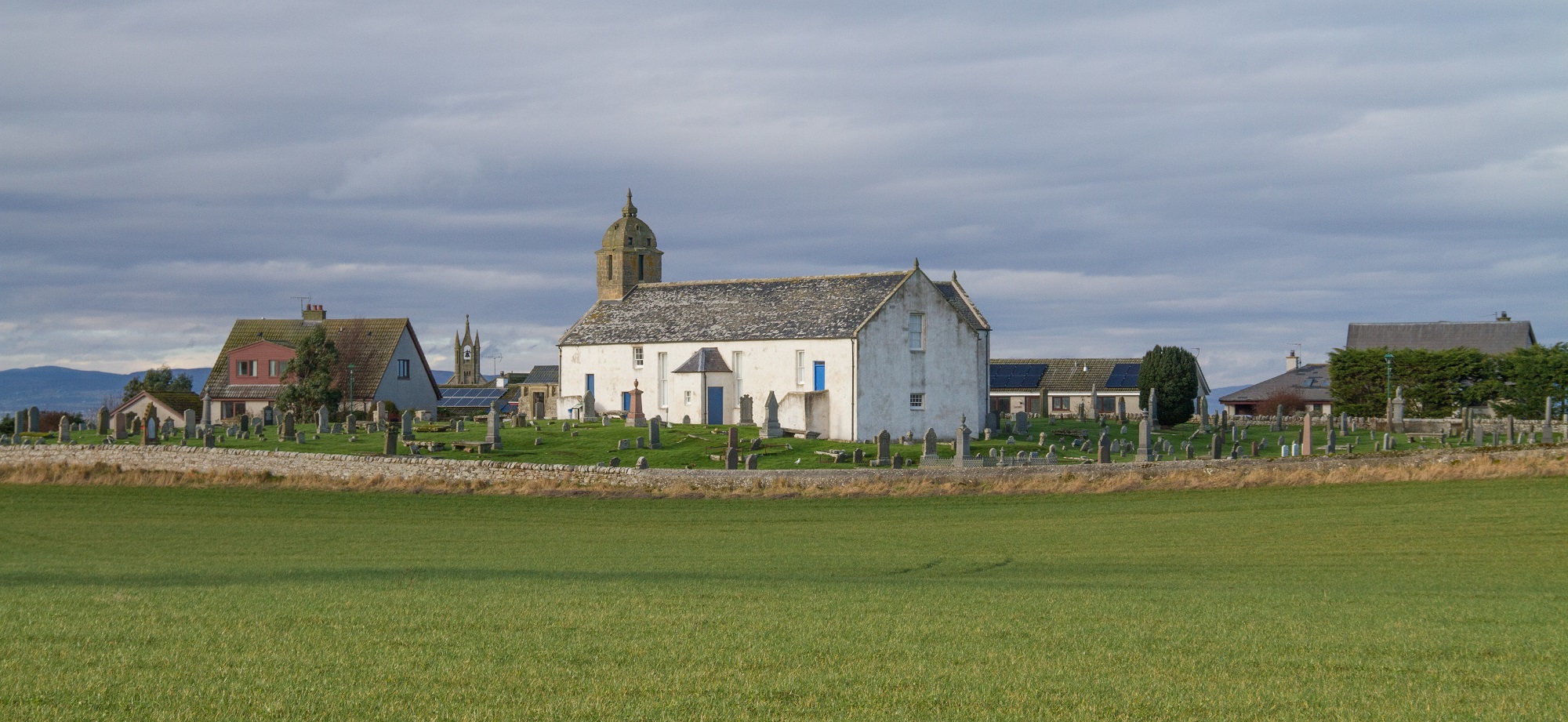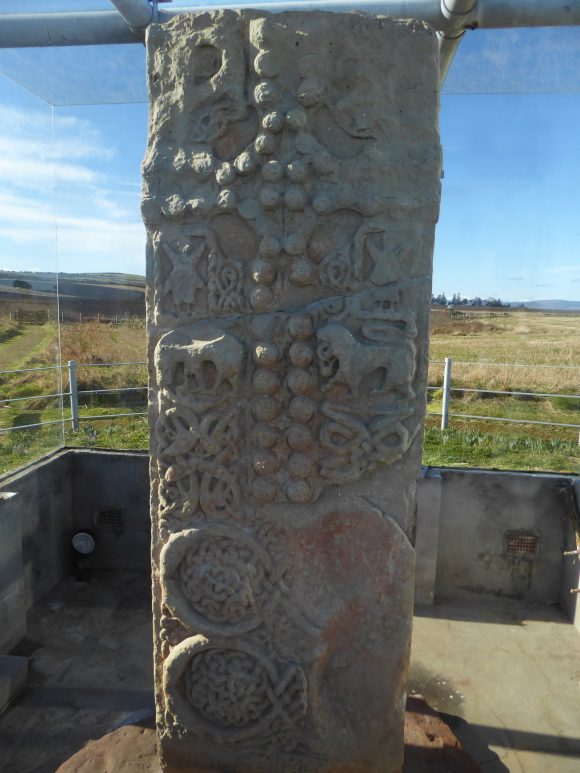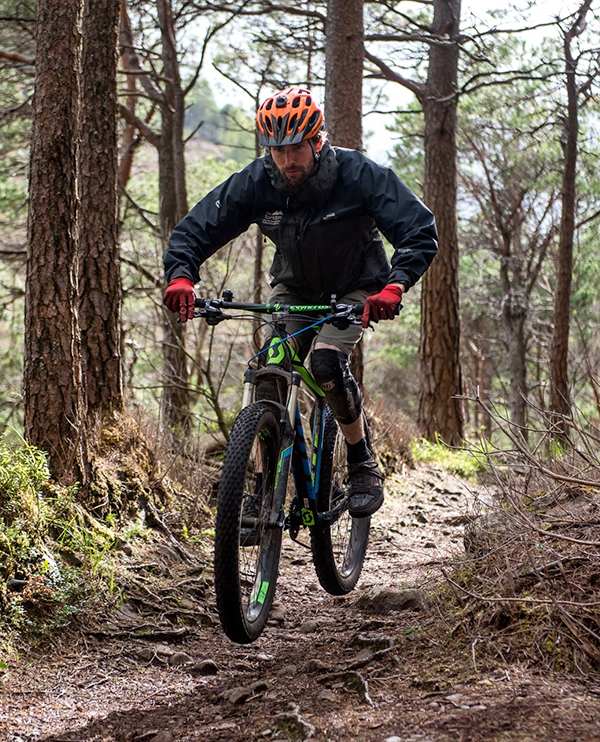The Pictish Trail
Their code is yet to be cracked!
The Easter Ross Pictish trail is a spectacular journey through a landscape which has been inhabited since the very earliest times.
“Mysterious and often beautiful, Pictish sculpture presents one of the great puzzles of Dark Age archaeology” (Joanna Close-Brooks 1989) Pictish art is recognised as some of the most exquisite in the world and is cherished and studied by scholars world-wide. As you explore the east coast, take time to discover the Pictish Trail.
 The Route
The Route
Leaving Inverness, follow the A9 northwards over the Kessock Bridge to the Black Isle.
Follow signs for Groam House Museum, Rosemarkie.
From here you can either continue across the Cromarty – Nigg car ferry (seasonal – to check timetable contact local
tourist offices) or follow the coast road around the Black Isle to Dingwall and Strathpeffer.
Sites 8 – 13 are signposted from the A9 at the Arabella roundabout ( on the map).
Who were the Picts?
The Picts lived in north and east Scotland in the 3rd to 9th centuries AD. We know little of their history as very few written records survive, and none in the Pictish language.
There are a few inscriptions however which suggest that they spoke a language closely related to both Welsh and Gaelic. The name first appears in Roman sources as Picti, meaning ‘the decorated or painted people’ – perhaps a reference to tattooing or war paint. However this may be the latinised form of an older name. In Gaelic the Picts are called Cruithne – the Welsh form of which has given us ‘Briton’ and ‘Britain’. They intermarried with the Irish Scotti and jointly raided Roman Britain. There were also extensive contacts with Anglo-Saxon Northumbria. Both these interactions can be seen in the art of the later carved stones. From the 9th century, Picts and Scots were both ruled by a single king – although by then, Shetland, Orkney, Caithness, Sutherland, and the Hebrides were all under Norwegian control.
Discover the Pictish Trail

Stone Carving
Along the route you can see beautiful Pictish sculpture on large Christian cross slabs, modern sculptures of the Pictish Queen and the Balintore Mermaid, a dramatic Stevenson Lighthouse, picturesque fishing villages and harbours, fertile farmlands, dramatic sea cliffs and modern oil industry technology. There are walks to explore with the chance to spot dolphins, maybe whales and seabirds and beautiful wild flowers. Fossils can be found at Shandwick and Hilton beaches.
The unique historic significance of the route is the presence and evidence of the Picts who were skilled sculptors of Christian symbols and accurate interpretations of real animals as well as mythical creatures. What was the Pictish beastie? They had knowledge of biblical stories.
The centres of information are the Tarbat Discovery Centre in Portmahomack and the Memorial Hall in the Seaboard villages of Hilton, Balintore and Shandwick.
The Picts lived in North and East Scotland from the 3rd to 9th centuries AD. We know little of their history as very few written records survive and none in the Pictish language. The Romans named them the Picti, the decorated or painted people. This may refer to tattooing or war paint but it may be that the cross slabs were painted.
Symbols and Designs
The Picts were gifted sculptors. Their symbols were very sophisticated and produced at a time when carvings in other areas were rudimentary. The symbols are a mixture of Christian and pagan, realistic figures, biblical references and mythical beasts.
The famous symbols are unique to the Picts. Their purpose and meaning are still unknown, but they appear over a long period on jewellery, and as graffitti, as well as on carved stones. They frequently appear in pairs, and have been interpreted as indicating particular kindreds, lineages or clans, or as a pictographic system of writing.
Also look out for cup-marks, which appear on some of the stones. These are circular hollows created in patterns on the face of a stone, and are generally thought to be prehistoric in date.
Highlights
Portmahomack – Tarbat Discovery Centre
A site of a monastic settlement which was raided by the Vikings. Remains excavated thought to be those of high class monks were found in the church which is now the Tarbat Discovery Centre. They show signs of a violent death.
Housed in the refurbished interior of Tarbat Old Parish Church, the Centre displays fragments of Pictish sculpture revealed by excavations at the site. They include cattle licking their new-born calf, a rooting wild boar, and a snarling dragon with a serpent head on its tail. There are also replicas and photographs of the pieces of Pictish sculpture from Tarbat which are now in the Museum of Scotland in Edinburgh. Excavations by the University of York have revealed an 8th-century Pictish monastery, its stone buildings, farm, and metalworking shop. It is thought that five cross slabs may have stood at the monastery. They were smashed by the Vikings.

Hilton of Cadboll – The Hilton of Cadboll cross-slab
Once stood outside St Mary’s chapel at Cadboll, the remains can still be seen as grass covered mounds. The original is in The National Museum of Scotland but a modern replica was erected in 2000. The base of the original is displayed in the Seaboard Memorial Hall. The main panel depicts a woman mounted on horse- back, accompanied by other mounted figures, musicians and animals in a detailed hunting scene. A mirror and comb symbol is to her left. Above are a crescent and V- rod and at the top, a double disc and Z-rod.

Photo: Seaboard Memorial Hall, Cadboll Stone Base

Shandwick – The Shandwick Stone
This impressive cross-slab was a landmark for local boats. It is now protected by a glass shelter. Facing the sea, its great cross is covered with bosses and interlocking spirals. On the back are five panels of decoration. At the top is a double-disc symbol above a Pictish beast, while another shows a hunting scene, fighting swordsmen and a hunter with a cross-bow. There is a complex pattern of serpents biting their own bodies. Its Gaelic name (Clach a’ Charaidh) means ‘stone of the grave-plots’. A burial ground here was recorded in 1889 as last used during the cholera epidemic of 1832.
Nigg – the Nigg Stone
This magnificent cross-slab now stands inside the church. The decoration has similarities with the 8th-century free-standing crosses on Iona, the St Andrews Sarcophagus (a Pictish royal shrine) and the illuminated gospel-book, of the same date, known as the Book of Kells. The great cross is set against a background of bosses made up of snakes, and the pediment above illustrates an episode in the life of St Paul the Hermit as told by St Jerome. On the reverse there is an eagle symbol, hunting scenes, and an illustration of the Biblical story of how David killed a lion in order to save a lamb in his flock. A detached fragment, including part of a Pictish beast symbol was found in 1998. It is currently in Tain Museum).
Let us know your highlights! Find out what else you can visit here: Pictish Trail A Guide To Pictish Sculpture From Inverness To Dunrobin
